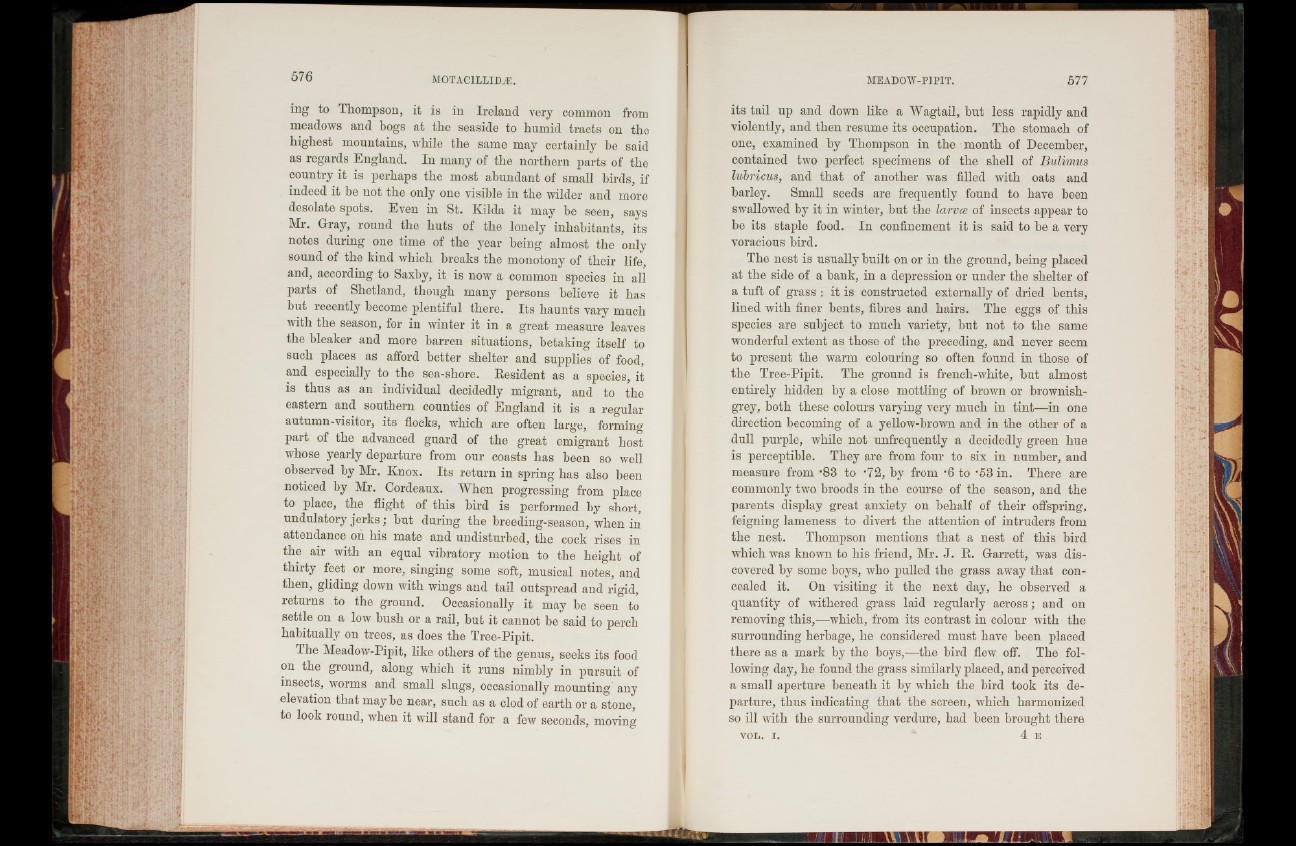
ing to Thompson, it is in Ireland very common from
meadows and bogs at the seaside to humid tracts on the
highest mountains, while the same may certainly be said
as regards England. In many of the northern parts of the
country it is perhaps the most abundant of small birds, if
indeed it be not the only one visible in the wilder and more
desolate spots. Even in St. Kilda it may be seen, says
Mr. Gray, round the huts of the lonely inhabitants, its
notes during one time of the year being almost the only
sound of the kind which breaks the monotony of their life,
and, according to Saxhy, it is now a common species in all
parts of Shetland, though many persons believe it has
but recently become plentiful there. Its haunts vary much
with the season, for in winter it in a great measure leaves
the bleaker and more barren situations, betaking itself to
such places as afford better shelter and supplies of food,
and especially to the sea-shore. Resident as a species, it
is thus as an individual decidedly migrant, and to the
eastern and southern counties of England it is a regular
autumn-visitor, its flocks, which are often large, forming
part of the advanced guard of the great emigrant host
whose yearly departure from our coasts has been so well
observed by Mr. Knox. Its return in spring has also been
noticed by Mr. Cordeaux. When progressing from place
to place, the flight of this bird is performed by short,
undulatory je rk s ; hut during the breeding-season, when in
attendance on his mate and undisturbed, the cock rises in
the air with an equal vibratory motion to the height of
thirty feet or more, singing some soft, musical notes, and
then, gliding down with wings and tail outspread and rigid,
returns to the ground. Occasionally it may be seen to
settle on a low bush or a rail, but it cannot be said to perch
habitually on trees, as does the Tree-Pipit.
The Meadow-Pipit, like others of the genus, seeks its food
on the ground, along which it runs nimbly in pursuit of
insects, worms and small slugs, occasionally mounting any
elevation that may be near, such as a clod of earth or a stone,
to look iound, when it will stand for a few seconds, moving
its tail up and down like a Wagtail, but less rapidly and
violently, and then resume its occupation. The stomach of
one, examined by Thompson in the month of December,
contained two perfect specimens of the shell of Bulimus
lubricus, and that of another was filled with oats and
barley. Small seeds are frequently found to have been
swallowed by it in winter, but the larva of insects appear to
be its staple food. In confinement it is said to be a very
voracious bird.
The nest is usually built on or in the ground, being placed
at the side of a bank, in a depression or under the shelter of
a tuft of grass : it is constructed externally of dried bents,
lined with finer bents, fibres and hairs. The eggs of this
species are subject to much variety, but not to the same
wonderful extent as those of the preceding, and never seem
to present the warm colouring so often found in those of
the Tree-Pipit. The ground is french-white, but almost
entirely hidden by a close mottling of brown or brownish-
grey, both these colours varying very much in tint—in one
direction becoming of a yellow-brown and in the other of a
dull purple, while not unfrequently a decidedly green hue
is perceptible. They are from four to six in number, and
measure from '83 to ‘72, by from -6 to -53 in. There are
commonly two broods in the course of the season, and the
parents display great anxiety on behalf of their offspring,
feigning lameness to divert the attention of intruders from
the nest. Thompson mentions that a nest of this bird
which was known to his friend, Mr. J. R. Garrett, was discovered
by some boys, who pulled the grass away that concealed
it. On visiting it the next day, he observed a
quantity of withered grass laid regularly across ; and on
removing this,-—which, from its contrast in colour with the
surrounding herbage, he considered must have been placed
there as a mark by the boys,—the bird flew off. The following
day, he found the grass similarly placed, and perceived
a small aperture beneath it by which the bird took its departure,
thus indicating that the screen, which harmonized
so ill with the surrounding verdure, had been brought there
v o l . i . 4 E